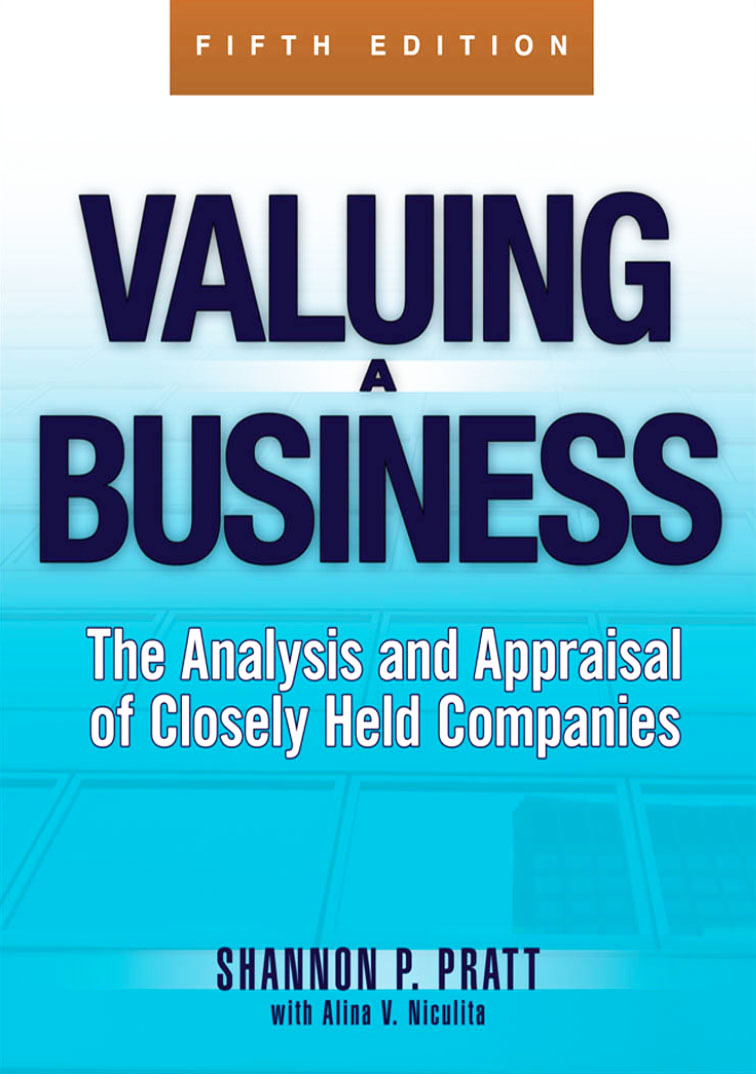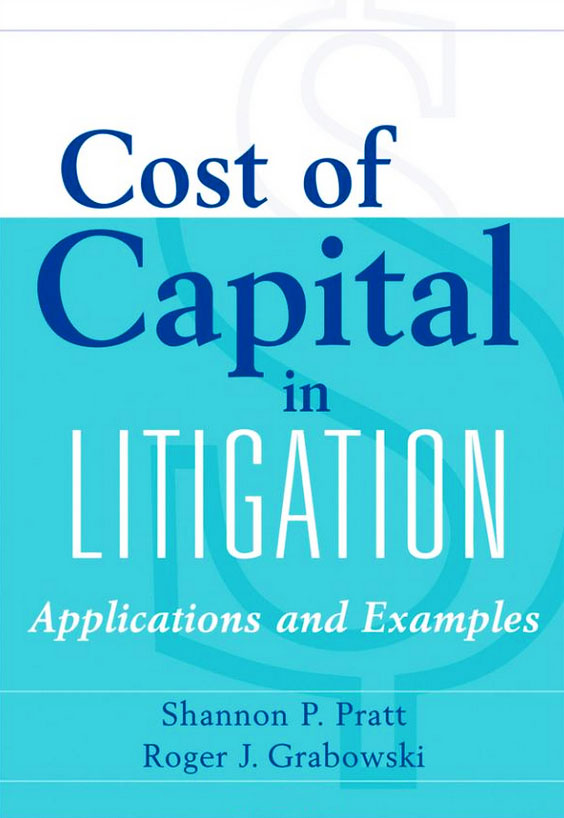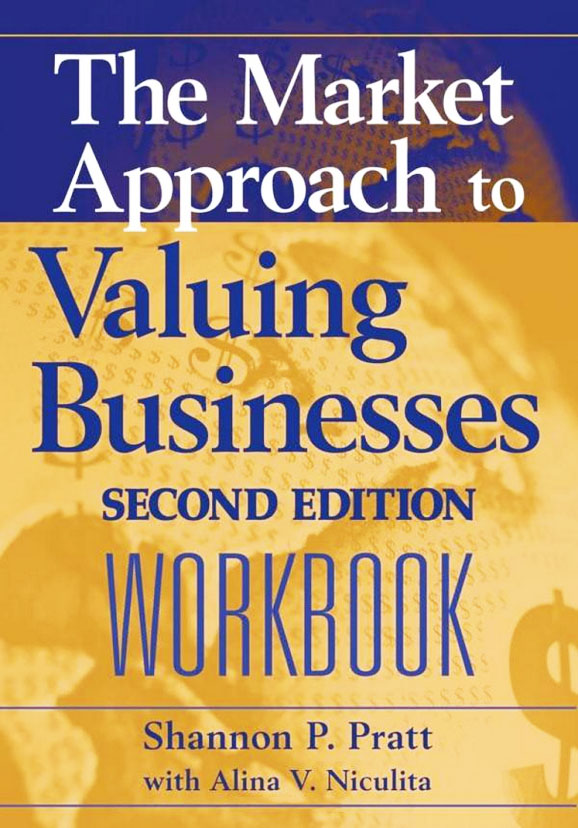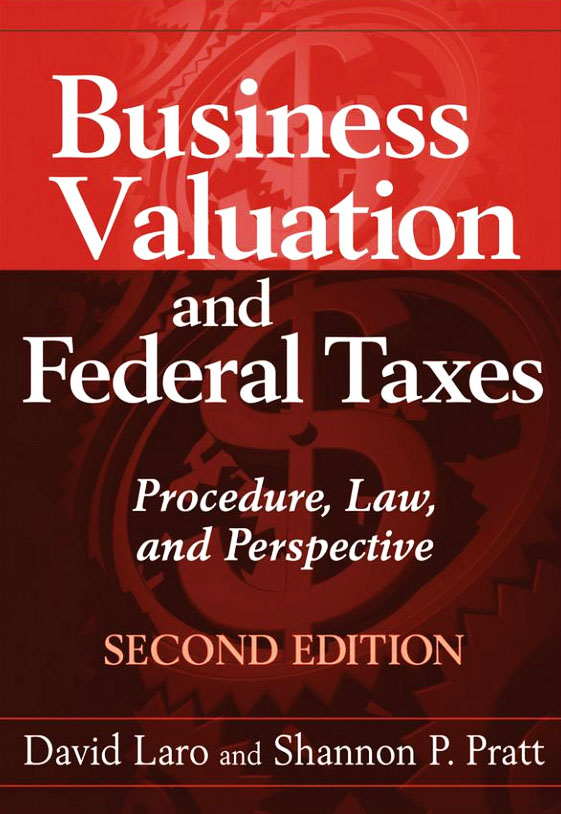The Lawyer’s Guide to The Cost of Capital
Table of Contents
Foreword: Cost of Capital
Foreword: Family Law Perspective
Foreword: Insolvency Perspective
About the Authors
About the Contributing Authors
Preface
Acknowledgments
Table of Abbreviations
Part 1 - Cost of Capital Basics
- Chapter 1 Defining Cost of Capital
- Chapter 2 Valuing Equity Versus Invested Capital
- Chapter 3 Net Cash Flow: The Preferred Measure of Economic Income
- Chapter 4 Discounting Versus Capitalizing
- Chapter 5 Estimating the Cost of Equity Capital
- Chapter 6 Components of Cost of Equity Capital
- Chapter 7 Adjusting a Discount or Capitalization Rate for Other Measures of Economic Income
- Chapter 8 Overall (Weighted Average) Cost of Capital
- Chapter 9 How Cost of Capital Relates to the Excess Earnings Method of Valuation
- Chapter 10 Handling Discounts for Lack of Marketability and Liquidity
- Chapter 11 Cost of Capital in Estate and Gift Tax Matters
- Chapter 12 Cost of Capital Considerations in Corporate Restructuring and Other Federal Tax Matters
- Chapter 13 Cost of Capital Included in Damage Claims for Lost Profits
- Chapter 14 Cost of Capital in Intellectual Property Disputes
- Chapter 15 Cost of Capital in Bankruptcy
- Chapter 16 Cost of Capital in Appraisal and Fairness Cases
- Chapter 17 Cost of Capital in Family Law Matters
- Chapter 18 Cost of Capital in Ad Valorem Taxation
- Chapter 19 Cost of Capital in Regulated Industries
- Chapter 20 Common Errors in Applying Cost of Capital
- Chapter 21 Questions to Ask Business Valuation Experts
Appendix II: International Glossary of Business Valuation Terms
Table of Cases
Index
Table of Exhibits
Foreword: Cost of Capital
Foreword: Family Law Perspective
Foreword: Insolvency Perspective
About the Authors
About the Contributing Authors
Preface
Acknowledgments
Table of Abbreviations
Part 1 - Cost of Capital Basics
Chapter 1 Defining Cost of Capital
Introduction
Cost of Capital Is Multifaceted
Cost of Capital Is Forward-Looking
Cost of Capital Is Based on Market Value
Cost of Capital Is Usually Stated in Nominal Terms
Cost of Capital Equals the Discount Rate
Cost of Capital Should Reflect the Risk of the Investment
Defining Risk
Understanding the Role of Risk
Chapter 2 Valuing Equity Versus Invested Capital
Introduction
Equity Capital
Invested Capital
Relationship Between Equity and Enterprise Value
Components of Common Equity
Components of Senior Securities
Fully Diluted Common Shares
Personal Guarantees
Components of a Capital Structure
Capital Structure at Book Value
Capital Structure at Market Value
Chapter 3 Net Cash Flow: The Preferred Measure of Economic Income
Introduction
Definition of Net Cash Flow
Net Cash Flow to Common Equity Capital
Net Cash Flow to Invested Capital
Why Net Cash Flow Should be Probability-Weighted Expected Values
Why Net Cash Flow Is the Preferred Measure of Economic Income
Chapter 4 Discounting Versus Capitalizing
Introduction
The Concept of Discounting
The Concept of Capitalizing
The Basic Capitalized Cash Flow Model
The Constant Income Capitalization Model
The Income Capitalization Growth Model
The Basic Discounted Cash Flow Model
The Discounted Cash Flow Model for a Limited
Life Investment
The Discounted Cash Flow Model Using a “Terminal Value”
Capitalization Model Versus Market Multiples for Estimating Terminal Value
Concept and Estimation of Discount Rates
The Concept of the Discount Rate
Elements of the Discount Rate: A Risk-Free Rate and a Premium for Risk
Estimating Discount Rates for Fixed-Income Securities
Equivalency of Discounting and Capitalizing Models
Discounting or Capitalizing—Which to Choose
Alternative Formulas for Discounting and Capitalizing
Midyear Discounting Convention
Midyear Capitalization Convention
Midyear Convention in the Two-Stage Model
Seasonal Businesses
Chapter 5 Estimating the Cost of Equity Capital
Introduction
The Build-Up Method
Risk-Free Rate
Equity Risk Premium
Size Premium
Industry Risk Factor
Company-Specific Risk Premium
The Capital Asset Pricing Model
Background of the CAPM
Assumptions Underlying the CAPM
Concept of Market or Systematic Risk
Modification of CAPM to Incorporate Size Premium and Company-Specific Risk Premium
Chapter 6 Components of Cost of Equity Capital
Introduction
Components of the Risk-Free Rate
Equity Risk Premium
Market or Systematic Risk
Using Beta to Estimate Market Risk
Unlevering and Levering Beta
Using Industry Risk Adjustment to Estimate Market Risk
Size Premium
Company-Specific Risk Premium
Size Smaller Than the Smallest Size Premium Group
Volatility of Returns
Leverage
Other Company-Specific Factors
Other Methods for Estimating the Cost of Equity Capital
Fama-French Three-Factor Model
Implied Cost of Equity Capital
Chapter 7 Adjusting a Discount or Capitalization Rate for Other Measures of Economic Income
Introduction
Converting a Capitalization Rate for Net Cash Flow to a Capitalization Rate for Another Economic Income Measure
Converting a Capitalization Rate with Zero Growth
Converting an After-Tax Discount Rate to a Capitalization Rate with Constant Growth
Converting an After-Tax Discount Rate to a Pretax Discount Rate with Constant Growth
Summary
Chapter 8 Overall (Weighted Average) Cost of Capital
Introduction
How to Compute WACC for a Public Company
How to Compute WACC for a Nonpublic Company
Whether to Use Actual or Hypothetical Capital Structures
Whether to Use Constant or Variable Capital Structures
When to Use WACC
Chapter 9 How Cost of Capital Relates to the Excess Earnings Method of Valuation
Introduction
Basic “Excess Earnings” Valuation Method
Conceptual Basis for the Method
Steps in Applying the Excess Earnings Method
Example of the Excess Earnings Method
Cost of Capital Reasonableness Check
Estimating a Capitalization Rate Using the Build-Up Method
Computing the Weighted Average Excess Earnings Capitalization Rate
Discussion of the Example
Vagaries of the Excess Earnings Method
Chapter 10 Handling Discounts for Lack of Marketability and Liquidity
Introduction
Using Databases of DLOMs for Minority Ownership Interests to Quantify Discounts for Lack of Marketability
Restricted Stock Transactions
Pre–Initial Public Offering Transactions
Using Options to Estimate DLOM
Chaffee Model
Longstaff Model
Finnerty Model
Long-Term Equity Anticipation Securities Studies
Comparison of Option Models to Empirical Data
Measuring Blockage (Illiquidity) Discounts for Public Companies
Using the Private Company Discount for Controlling Interests in Operating Businesses
Relationship Between DLOM for Minority Interests and PCD
Discounts Observed in Private Company Discount Studies
Reasons for the Private Company Discount
Building the Discount for Lack of Marketability into the Discount Rate
Venture Capitalists’ Required Rates of Return
Discount Rate Adjustments for Lack of Marketability
Part II - Cost of a Capital in Specific Contexts
Chapter 11 Cost of Capital in Estate and Gift Tax Matters
Introduction
Acceptance and Rejection of DCF
Evaluation of Cash Flow Forecasts
Cost of Equity Capital Versus WACC
Build-Up, CAPM, or Something Else?
Cost of Equity Capital
Small Company Risk Premium
Company-Specific Risk Premium
Failure to Account for Unsystematic Risk
Impounding DLOM into Discount Rate
Consistency of Data
Courts Demand Supporting Detail
Cost of Capital for a Regulated Company
S Corporations
Summary
Chapter 12 Cost of Capital Considerations in Corporate Restructuring and Other Federal Tax Matters
Introduction
Legal Entity Valuations
Legal Entity Valuations as Part of an Acquisition
Legal Entity Valuations Outside of an Acquisition
Income Tax Considerations
Minority Interest Considerations
Example of Legal Entity Valuation Dispute
Background
Intercompany Debt
Worthless Stock
Transfer Pricing Disputes
Tax Benefits Due to Asset Step-Ups
Discount for Lack of Marketability
Summary
Chapter 13 Cost of Capital Included in Damage Claims for Lost Profits
Introduction
The Importance of Discounting
Appropriateness of a Risk-Free Discount Rate
Cost of Capital Is the Appropriate Risk-Adjusted Discount Rate
Tax Effects
Common Errors in Discounting Lost Profits
Exclusion of Expert Testimony
Summary
Chapter 14 Cost of Capital in Intellectual Property Disputes
Introduction
Categories of Intellectual Property Rights
Patent Infringement Damages
Copyright Infringement Damages
Trademark Infringement Damages
Misappropriation of Trade Secret Damages
Breach of Contract Damages
Court Guidance Regarding Discount Rate Selection
Tax Effects
Ex Ante or Ex Post Damages
Prejudgment Interest Rates
Developments in Patent Infringement Damages Law
Injunctions Versus Ongoing Royalties
Foreign Sales
Applicable Revenues
Comparable Licenses
Noninfringing Alternatives
Royalties in the Context of Standards
Other Cases
Summary
Chapter 15 Cost of Capital in Bankruptcy
Introduction
Cost of Capital for Debt
Debtor-in-Possession Lending
Supreme Court’s Views on Cram Down Loans
Cost of Capital for a Business Enterprise
Solvency Valuation for Fraudulent Conveyance and Preference Claims
Enterprise Valuation for Secured Claims Analysis
Reorganization Value for Plan Confirmation
WACC for Highly Leveraged Enterprises
Summary
Chapter 16 Cost of Capital in Appraisal and Fairness Cases
Introduction
Discounted Cash Flow in Delaware Law
Capital Asset Pricing Model
Components of Weighted Average Cost of Capital
Risk-Free Rate
Cost of Equity
Cost of Debt
Capital Structure
Beta
Industry Risk Premium
Size Premium
Company-Specific Risk Premium
Build-Up Method
Additional Points
Role of the Expert
Summary
Chapter 17 Cost of Capital in Family Law Matters
Introduction
Cost of Equity Capital Versus WACC
Capital Structure: Industry Versus Business
Market Value Weight Proportions and the Cost of Equity Capital
The Hidden Impact of Rounding
Cost of Capital in Family Law Courts
New York
Indiana
Colorado
Nebraska
Connecticut
Virginia
Michigan
Arkansas
Summary
Chapter 18 Cost of Capital in Ad Valorem Taxation
Introduction
Unitary Property Cost of Capital by State
California
Colorado
Nevada
Oklahoma
Texas
Washington
Wyoming
Company Cost of Capital Versus Asset Cost of Capital
Asset Valuation
Definitions
Special Use Property
Variability of Cash Flow and Returns
Difference Between Cost of Capital for a Business and a Single Asset
Assessed Value Versus Market Value
General Categories of Legislative Constraints That Necessitate Adjustments to the Cost of Capital
Tangible Assets Including Assemblage or Enhancement
Operating Property in Existence on a Lien Date
Capital Structure
Weighted Average Cost of Capital
Cost of Equity Capital
Cost of Preferred Equity Capital
Cost of Debt Capital
Ad Valorem Tax Adder
Pretax Discount Rates
Flotation Costs
Cost of Capital in the Courts
Chapter 19 Cost of Capital in Regulated Industries
Introduction
Overview of Regulatory Decision-Making Process
Role for Cost of Capital
Alternative Approaches to Setting Cost of Capital
Base Rate Case
California Cost of Capital Proceeding
Special Adjustment Mechanisms
Utility Cost of Capital Measurement Issues
Financial Metrics Used to Assess Financial Condition Under Current Rates
Metrics Used by Credit Rating Agencies
Special Issues
Challenges in Estimation Due to Financial Conditions Leading to “Great Recession”
Specific Issues by Technique
DCF Method
CAPM
Empirical CAPM
Bond Rate Differential
Other Methods
Fama-French Three-Factor Model
Market-Derived Capital Pricing Model
Predictive Risk Premium Model™
Behavioral Finance
Railroad Cost of Capital Issues
ECAPM
Multistage DCF Method
Summary
PART III - Evaluating Experts
Chapter 20 Common Errors in Applying Cost of Capital
Introduction
General Errors
Making Assumptions That Produce a Standard of Value Other Than That Specified in the Valuation Engagement
Using a Safe Rate to Discount or Capitalize a Risky Return
Confusing Discount Rates with Capitalization Rates
Using the Same WACC to Value Different Businesses Owned by a Diversified Company
Using the Firm’s Cost of Capital to Evaluate a More or Less Risky Acquisition or Project
Using Both the Discounting and Capitalizing Methods and Weighting Them
Selecting One Period from a Data Set for Estimating One Variable and Another Period from the Same Data Set to Estimate Another Variable
Adjusting the Balance Sheet for Nonoperating Assets Without Adjusting the Income Statement (or Vice Versa)
Developing Discount and Capitalization Rates
Subtracting a Short-Term Growth Rate from the Discount Rate to Get a Capitalization Rate
Using an Industry Risk Premium with Noncomparable Companies
Blindly Accepting the Long-Term Average as Today’s Equity Risk Premium
Mistaking Historical Rates of Return for Expected Rates of Return
Using Incorrect or Inadequately Supported Data in Estimating the Cost of Equity
Using Different Betas to Estimate Beta for the Subject Company Than Are Used in the Guideline Company Method
Using an Inappropriate Beta in the CAPM
Using an Inappropriate Beta in a Multifactor Model
Failing to Use the “Iterative Method” to Estimate the Proportions of Debt and Common Equity in the Capital Structure When the Value of Common Equity Is Unknown
Mismatching Economic Income
Applying a Discount Rate Applicable to Net Cash Flow to Net Income
Applying a Discount Rate in Real Terms to an Economic Income Projection in Nominal (Current) Terms
Substituting EBITDA for Net Cash Flow
Applying Costs of Capital Derived from After-Tax Returns to Pretax Net Cash Flows
Making Projections
Projecting Growth Beyond That Which the Capital Being Valued Will Support
Using the Most Likely Forecast Instead of the Probability-Weighted Forecast
Making Pure Mechanical Projections from Past Results
Accepting Management’s Projections Without Analysis
Other Errors in Estimating Net Cash Flows
Terminal Value
Discounting the Terminal Value for N + 1 Periods
Using an Unattainable Growth Rate in Calculating the Terminal Value
Using Market Multiples Without Adjusting for Differences in Growth
Capital Structure
Internally Inconsistent Capital Structure Projection
Overlooking the Current Portion of Long-Term Debt in the Capital Structure When Computing the Proportions of Debt in the Capital Structure
Excess Earnings Method
Failure to Separate (or Even Recognize) Excess Assets
Conformation of WACC to the Capitalization Rate as Developed in This Book
Capitalization of Tangible Assets at the Risk-Free Rate
An Excess Earnings Method Valuation That Results in an Unrealistic Cost of Capital
Failure to Provide Detailed Explanations
Errors in Discounting Lost Profits
The Most Common Error in Discounting Lost Profits Is Using a Risk-Free Discount Rate
Using the Methods Appropriate to the Discounting of the Lost Earnings of an Individual to Discount the Lost Profits of a Business
Exclusion of Expert Testimony
Summary
Chapter 21 Questions to Ask Business Valuation Experts
Introduction
Examination Outline
Questions on Admissibility and Impact of Expert
Questions on Expert’s Practice and Work Done on Engagement
Questions on Overview of the Assignment
Questions on the Income Approach: General
Questions on Discounting Method
Questions on Capitalization Method
Questions on Cost of Capital
Questions on the Build-Up Method
Questions on CAPM and Modified CAPM
Questions on Debt Capital of Subject Company
Questions on Marketability of Interest If Closely Held Entity Being Valued
Questions on Estimating Net Cash Flows
Appendix I: Bibliography
Appendix II: International Glossary of Business Valuation Terms
Table of Cases
Index

Valuing a Business: The Analysis and Appraisal of Closely Held Companies, 5th Edition

Cost of Capital, 5th Edition

The Lawyer’s Guide to The Cost of Capital

Cost of Capital in Litigation

Standards of Value: Theory and Applications

The Best of Shannon Pratt

PPC's Guide to Business Valuations

Valuing Small Businesses and Professional Practices, 3rd Edition

The Market Approach to Valuing Businesses, 2nd Edition

Business Valuation Discounts and Premiums, 2nd Edition

The Lawyer's Business Valuation Handbook, 2nd Edition

Business Valuation Body of Knowledge: Exam Review and Professional Reference, 2nd Edition

Business Valuation and Federal Taxes: Procedure, Law, and Perspective, 2nd Edition

